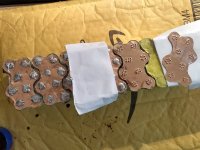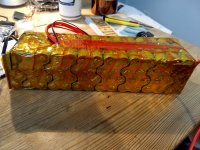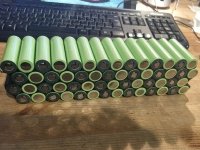Hickbeard
100 W
- Joined
- Nov 30, 2019
- Messages
- 186
I'm looking at spot welding my next pack and looking at stepping up things.
So reading through various battery threads including pack design mistakes thread (love that thread).
If we use 0.15mm 8mm nickel strip and it has 5a cont current rating then building a 20s pack in the manner in the pic would allow for 50a cont current correct? 10 tabs running in between each P group. Ignore the orange bit for the minute.
So to safely increase current handling of pack we'd want to double up the strips which would double the ability of the pack to draw 100a?
Obviously other things to be considered like battery specs, cabling, etc. But just the physical battery connections this is correct, correct?[emoji2955]
Now if the P group connection has to take more current/have less resistance than the S group connections, could you solder the nickel to a copper bar.
This would then increase current handling without the need to double up nickel strip.
So say I've got a 20s10p pack double thickness nickel across everything. And say I had a 3kw motor. Then say you wanted to set a 250w ish limit. If we programmed the controller to only run 5a battery draw would this pack be too big/too much resistance for such a small current draw?
Could you massively overspec a battery to run a multitude of current ranges. Say moped mode 100a, legalish uk mode 250w/5a, off road ebike mode 50a? BMS would be set to a kinda max limit of the battery in our example 100a. Then controller would limit the current to obtain desired current.
Or does this depend on the type of motor used as well?

Sent from my CLT-L09 using Tapatalk
So reading through various battery threads including pack design mistakes thread (love that thread).
If we use 0.15mm 8mm nickel strip and it has 5a cont current rating then building a 20s pack in the manner in the pic would allow for 50a cont current correct? 10 tabs running in between each P group. Ignore the orange bit for the minute.
So to safely increase current handling of pack we'd want to double up the strips which would double the ability of the pack to draw 100a?
Obviously other things to be considered like battery specs, cabling, etc. But just the physical battery connections this is correct, correct?[emoji2955]
Now if the P group connection has to take more current/have less resistance than the S group connections, could you solder the nickel to a copper bar.
This would then increase current handling without the need to double up nickel strip.
So say I've got a 20s10p pack double thickness nickel across everything. And say I had a 3kw motor. Then say you wanted to set a 250w ish limit. If we programmed the controller to only run 5a battery draw would this pack be too big/too much resistance for such a small current draw?
Could you massively overspec a battery to run a multitude of current ranges. Say moped mode 100a, legalish uk mode 250w/5a, off road ebike mode 50a? BMS would be set to a kinda max limit of the battery in our example 100a. Then controller would limit the current to obtain desired current.
Or does this depend on the type of motor used as well?

Sent from my CLT-L09 using Tapatalk




